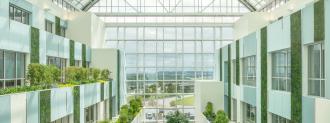Architects are turning to the human brain for inspiration, designing medical facilities with features that neuroaesthetics research suggests will promote positive mental health — but can well-designed buildings really help people heal?
Neuroaesthetics 101: Aesthetics is the philosophical study of beauty and taste. It focuses on our experience with beautiful things — how we feel while looking at a painting, listening to a song, or taking in a sunset, for example.
Neuroaesthetics is a sub-field of aesthetics. Instead of focusing on how beautiful things make us feel, it explores what’s going on in our brains while we experience them — it’s the hunt for links between beauty and biology.
While still a nascent field, it is already yielding new discoveries — neuroaesthetics researchers at University College London, for example, discovered that art or songs people deem to be beautiful cause increased activity in the brain’s medial orbito-frontal cortex.
“People might forget the details of how a space looks … but hardly anyone forgets how it made you feel.”
Suchi Reddy
Building on neuroscience: Within the field of neuroaesthetics is another sub-field: neuroarchitecture. It focuses on using insights gleaned from neuroaesthetics research to design spaces that make us feel good.
“People might forget the details of how a space looks or what it did, but hardly anyone forgets how it made you feel or how it doesn’t make you feel,” architect Suchi Reddy said during the Academy of Neuroscience for Architecture’s annual conference in 2018.
More time spent in places that prompt positive feelings may translate to better mental health — consider the psychological impact of spending a week in a windowless room versus one with a stunning mountain view.
For that reason, some architects are now trying to apply neuroaesthetics to the design of medical facilities for people with mental and behavioral health issues.
The verdict? The hope is that incorporating more views of nature, curved contours, and other elements known to make people feel good will help patients thrive — but we don’t know for sure yet whether that’s the case.
As Anjan Chatterjee, founding director of the University of Pennsylvania’s Penn Center for Neuroaesthetics, told NEO.LIFE, it’s not enough to build these facilities — we now need researchers who can figure out how to study how patients respond to the design choices.
“Once a building is done, that’s when you can continue to do the research to see if your predictions and expectations of what the experience would be for the inhabitants are actually true,” he said. “That then allows you to modify the next designs based on your initial ideas.”
We’d love to hear from you! If you have a comment about this article or if you have a tip for a future Freethink story, please email us at [email protected].






